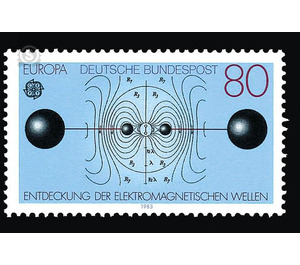Europe: Great works of the human mind - Germany / Federal Republic of Germany 1983 - 80 Pfennig
Theme: Post & Philately
| Country | Germany / Federal Republic of Germany |
| Issue Date | 1983 |
| Face Value | 80.00 |
| Color | blue |
| Perforation | K 14:14 1/4 |
| Printing Type | Six-color offset printing |
| Stamp Type | Postage stamp |
| Item Type | Stamp |
| Chronological Issue Number | 1049 |
| Chronological Chapter | GER-BRD |
| SID | 311271 |
| In 51 Wishlists | |
For the Xth Ordinary General Assembly of the CEPT in Brussels, the theme "Great Works of the Human Spirit" has been selected for 1983. In 1861 English mathematician James Clark Maxwell published a comprehensive theory of electrical and magnetic phenomena, with which he explained all the phenomena known so far. He was able to rely on investigations by the English naturalist Michael Faraday. However, in order to be able to fully confirm the theory, there had to be electromagnetic waves, which have the property of being able to propagate freely in space. 26 years later - in 1887 - the German physicist Heinrich Hertz succeeded in proving the existence of these waves. Technical applications of the Hertzian discovery accompany us today at every turn: for example, based on wireless messaging, radar and non-contact heating. (Text: Heinrich Hertz Institute for Telecommunications, Berlin)


